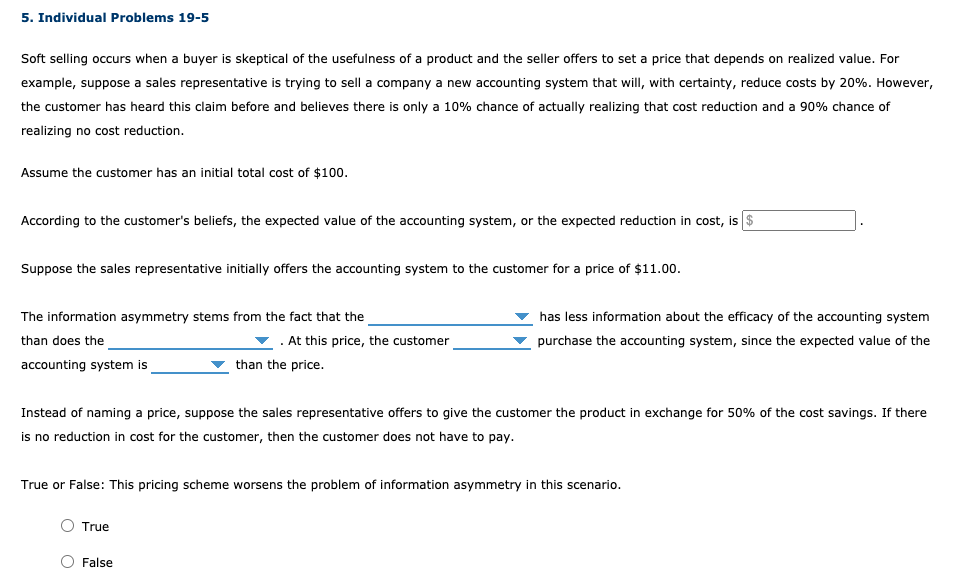Soft selling occurs when a buyer is skeptical of the usefulness of a product and the seller offers to set a price that depends on realized value. For example, suppose a sales representative is trying to sell a company a new accounting system that will, with certainty, reduce costs by 20%. However, the customer has heard this claim before and believes there is only a 10% chance of actually realizing that cost reduction and a 90% chance of realizing no cost reduction. Assume the customer has an initial total cost of $100. According to the customer's beliefs, the expected value of the accounting system, or the expected reduction in cost, is $ Suppose the sales representative initially offers the accounting system to the customer for a price of $11.00. The information asymmetry stems from the fact that the has less information about the efficacy of the accounting system . At this price, the customer than does the purchase the accounting system, since the expected value of the accounting system is than the price. Instead of naming a price, suppose the sales representative offers to give the customer the product in exchange for 50% of the cost savings. If there is no reduction in cost for the customer, then the customer does not have to pay. True or False: This pricing scheme worsens the problem of information asymmetry in this scenario. True False
Soft selling occurs when a buyer is skeptical of the usefulness of a product and the seller offers to set a price that depends on realized value. For example, suppose a sales representative is trying to sell a company a new accounting system that will, with certainty, reduce costs by 20%. However, the customer has heard this claim before and believes there is only a 10% chance of actually realizing that cost reduction and a 90% chance of realizing no cost reduction. Assume the customer has an initial total cost of $100. According to the customer's beliefs, the expected value of the accounting system, or the expected reduction in cost, is $ Suppose the sales representative initially offers the accounting system to the customer for a price of $11.00. The information asymmetry stems from the fact that the has less information about the efficacy of the accounting system . At this price, the customer than does the purchase the accounting system, since the expected value of the accounting system is than the price. Instead of naming a price, suppose the sales representative offers to give the customer the product in exchange for 50% of the cost savings. If there is no reduction in cost for the customer, then the customer does not have to pay. True or False: This pricing scheme worsens the problem of information asymmetry in this scenario. True False
Managerial Economics: Applications, Strategies and Tactics (MindTap Course List)
14th Edition
ISBN:9781305506381
Author:James R. McGuigan, R. Charles Moyer, Frederick H.deB. Harris
Publisher:James R. McGuigan, R. Charles Moyer, Frederick H.deB. Harris
Chapter3: Demand Analysis
Section: Chapter Questions
Problem 2.3CE
Related questions
Question
Please see the image below and help answer the questions.

Transcribed Image Text:5. Individual Problems 19-5
Soft selling occurs when a buyer is skeptical of the usefulness of a product and the seller offers to set a price that depends on realized value. For
example, suppose a sales representative is trying to sell a company a new accounting system that will, with certainty, reduce costs by 20%. However,
the customer has heard this claim before and believes there is only a 10% chance of actually realizing that cost reduction and a 90% chance of
realizing no cost reduction.
Assume the customer has an initial total cost of $100.
According to the customer's beliefs, the expected value of the accounting system, or the expected reduction in cost, is $
Suppose the sales representative initially offers the accounting system to the customer for a price of $11.00.
The information asymmetry stems from the fact that the
than does the
has less information about the efficacy of the accounting system
. At this price, the customer
purchase the accounting system, since the expected value of the
accounting system is
than the price.
Instead of naming a price, suppose the sales representative offers to give the customer the product in exchange for 50% of the cost savings. If there
is no reduction in cost for the customer, then the customer does not have to pay.
True or False: This pricing scheme worsens the problem of information asymmetry in this scenario.
True
O False
Expert Solution
This question has been solved!
Explore an expertly crafted, step-by-step solution for a thorough understanding of key concepts.
This is a popular solution!
Trending now
This is a popular solution!
Step by step
Solved in 3 steps

Knowledge Booster
Learn more about
Need a deep-dive on the concept behind this application? Look no further. Learn more about this topic, economics and related others by exploring similar questions and additional content below.Recommended textbooks for you

Managerial Economics: Applications, Strategies an…
Economics
ISBN:
9781305506381
Author:
James R. McGuigan, R. Charles Moyer, Frederick H.deB. Harris
Publisher:
Cengage Learning

Essentials of Economics (MindTap Course List)
Economics
ISBN:
9781337091992
Author:
N. Gregory Mankiw
Publisher:
Cengage Learning

Principles of Macroeconomics (MindTap Course List)
Economics
ISBN:
9781305971509
Author:
N. Gregory Mankiw
Publisher:
Cengage Learning

Managerial Economics: Applications, Strategies an…
Economics
ISBN:
9781305506381
Author:
James R. McGuigan, R. Charles Moyer, Frederick H.deB. Harris
Publisher:
Cengage Learning

Essentials of Economics (MindTap Course List)
Economics
ISBN:
9781337091992
Author:
N. Gregory Mankiw
Publisher:
Cengage Learning

Principles of Macroeconomics (MindTap Course List)
Economics
ISBN:
9781305971509
Author:
N. Gregory Mankiw
Publisher:
Cengage Learning

Brief Principles of Macroeconomics (MindTap Cours…
Economics
ISBN:
9781337091985
Author:
N. Gregory Mankiw
Publisher:
Cengage Learning

Principles of Economics (MindTap Course List)
Economics
ISBN:
9781305585126
Author:
N. Gregory Mankiw
Publisher:
Cengage Learning

Principles of Macroeconomics (MindTap Course List)
Economics
ISBN:
9781285165912
Author:
N. Gregory Mankiw
Publisher:
Cengage Learning